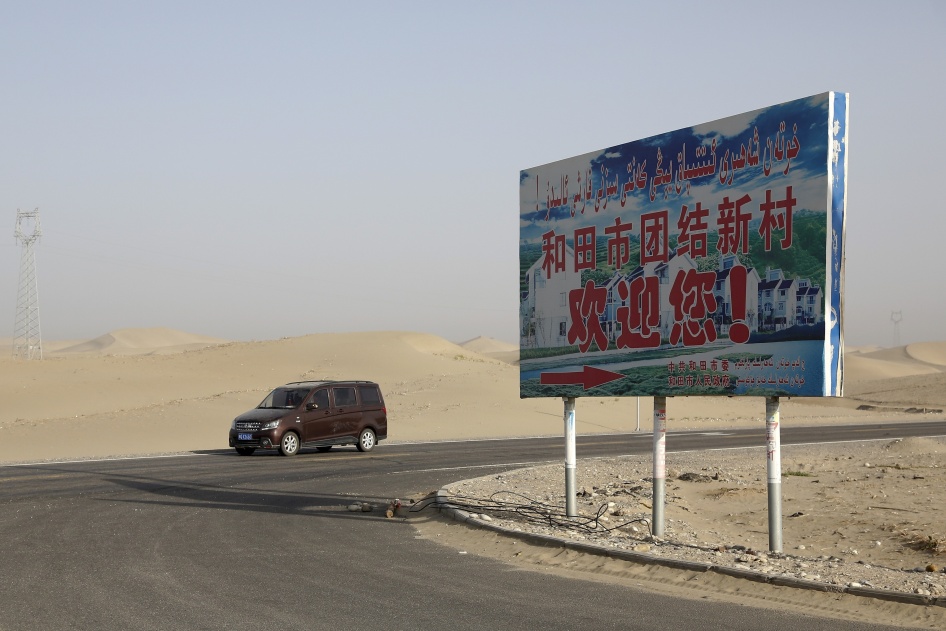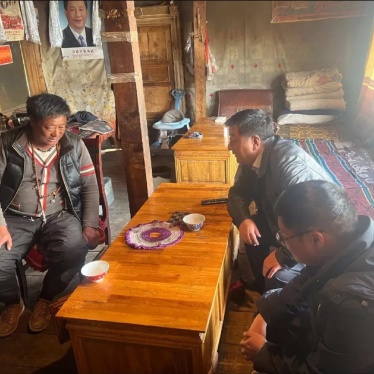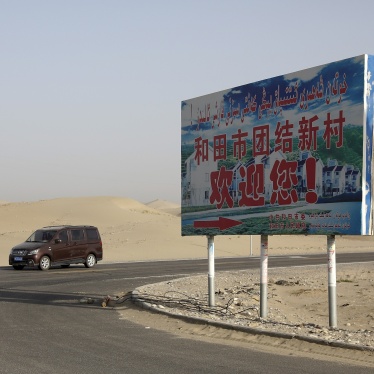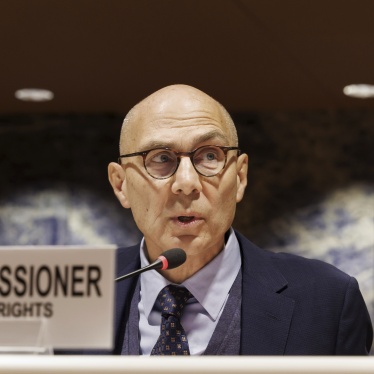(紐約)-人權觀察今天表示,中國當局在新疆有系統地變更數百座村莊名稱,將原本帶有維吾爾族宗教、歷史或文化意涵的名稱換成反映中國共產黨當前意識形態的名稱。
人權觀察研究發現,自2017年以來約有630個村莊被如此更名。最常用的前三個替換村名是「幸福」、「團結」與「和諧」。
「中國當局正在更改數以百計維吾爾村莊的名稱,將原本對維吾爾人饒富意義的村名換成政府宣傳詞彙,」人權觀察中國部代理主任王松蓮說。「村名變更似乎是中國政府抹消維吾爾人文化與宗教表達的措施之一。」
在這項聯合研究中,人權觀察和設於挪威的維吾爾援助組織(Uyghur Hjelp)從中國國家統計局網站上抓取了2009年到2023年的新疆村莊名稱。
全新疆25,000個村莊中,大約3,600個村莊在這段期間更名,其中五分之四看似正常調整,例如更改排序數字,或訂正名稱誤植。但有630個即五分之一的村莊原本具宗教、文化或歷史性質的名稱遭到替換。
更名有三種類型。凡是提及宗教的村名一律遭到更換,包括伊斯蘭詞彙,例如蘇菲派教士霍加(Hoja)和蘇菲派建築哈尼喀(haniqa)、也包括薩滿教詞彙,例如巫師巴合希。
凡是提及維吾爾歷史的村名也被替換,包括曾由維吾爾人建立的王國、共和國領導人以及1949年中華人民共和國建立前的地方士紳姓名,乃至意為王宮的歐爾達(orda)、政治或榮譽官銜蘇里坦(sultan)、博克(beg)。當局還換掉村名中象徵維吾爾文化的字眼,例如麻扎(mazar),即聖徒墓地,以及都塔爾(dutar),即作為維吾爾音樂文化核心的兩弦琴。
類似的更名措施似乎仍在持續進行,但大多發生在2017到2019年之間,即中國政府在新疆實施危害人類罪行的期間,而且大多發生在新疆南部喀什、阿克蘇及和田等維吾爾居民佔多數地區。
由於無法進入新疆地區,村名變更對居民生活的影響尚難充分查明。維吾爾援助組織訪問到11名曾在被更名村莊居住維吾爾人,發現村名變更的經驗對他們造成深刻衝擊。一名從再教育營獲釋的村民在回家途中遇到困難,因為售票系統裡面找不到原來的車站。後來她在申請各項政府服務的時候也因為村名變更而經常遇到麻煩。另一位村民說,他寫了一首詩並請人譜成歌曲,紀念故鄉周圍所有消失的地名。
中國已簽署但未批准的《公民權利和政治權利國際公約》第27條明定,「凡有種族、宗教或語言少數團體之國家,屬於此類少數團體之人,與團體中其他分子共同享受其固有文化、信奉躬行其固有宗教或使用其固有語言之權利,不得剝奪之。」
聯合國人權事務委員,即專責解釋前述公約的獨立專家機構,在其一般性意見中指出:「保護這些權利的目的是要確保有關少數群體的文化、宗教和社會特性得以存活和持續發展,從而豐富整個社會構造。⋯⋯這些權利本身必須受到保護」。
2014年5月,中國政府在新疆自治區發動「嚴厲打擊暴力恐怖活動專項行動」。從2017年起,中國政府對新疆維吾爾族和其他突厥裔穆斯林實施廣泛且有計劃的攻擊,包括大規模任意拘禁、酷刑、強迫失蹤、大規模監控、文化和宗教迫害、拆散家庭、強迫勞動、性暴力以及違反生殖權利。人權觀察於2021年認定前述各種侵犯行為構成危害人類罪。
中國政府向來將維吾爾人的日常宗教與文化活動,乃至他們對身分認同的表達,和暴力極端主義混為一談,藉此合理化對他們的侵犯行為。2017年4月, 中國政府制定《新疆維吾爾自治區去極端化條例》,禁止「以非正常...起名渲染宗教狂熱」。據報導,當局禁止了數十種世界各地穆斯林常用、帶有宗教意涵的姓名,例如薩達姆(Saddam)、麥迪娜(Medina),理由就是這些名字可能「渲染宗教狂熱」。
2022年8月,聯合國人權事務高級專員辦事處發表報告並於結論指出,中國政府在新疆的迫害行為「可能構成國際犯罪,特別是危害人類罪。」人權觀察表示,儘管許多國家對中國政府的新疆政策發出譴責,並有部分國家對涉及侵犯人權的中國政府官員、機構和企業實施針對制裁或其他制裁,這些應對措施仍與中國政府暴行的嚴重程度相去甚遠。
「有關各國政府和聯合國人權辦事處應加大力度追究中國政府在維吾爾地區的侵害行為,」維吾爾援助組織創辦人阿卜杜韋力・阿尤普(Abduweli Ayub)說。「應當利用即將召開的聯合國人權理事會會議和所有高級别雙邊會談,施壓中國政府釋放因其嚴打行動而仍遭不法關押的數十萬維吾爾人。」
有關村名變更的更多詳情,請參閱下文。
Examples of Village Name Changes
- In Kashgar Prefecture, Qutpidin Mazar village (库普丁麻扎村), named after a shrine of the 13th century Persian polymath and poet, Qutb al-Din al-Shirazi, was renamed Rose Flower village (玫瑰花村) in 2018;
- In Akto County, Kizilsu Kyrgyz Autonomous Prefecture, Aq Meschit (“white mosque”) village (阿克美其特村) was renamed Unity village (团结村) in 2018;
- In Aksu Prefecture, Hoja Eriq (“Sufi teacher’s creek”) village (霍加艾日克村), was renamed Willow village (柳树村) in 2018;
- In Karakax County, Dutar village (都塔尔村), named after a Uyghur musical instrument, was renamed Red Flag village (红旗村) in 2022.
A full list of these village names is available upon request.
Methodology
The National Bureau of Statistics of China publishes a list of “Administrative Division Codes for Statistics,” (统计用区划代码) in which each village is represented by a 12-digit code. These digits identify villages by the five administrative levels of China: province, city/prefecture, county, township, and village. In total, we were able to identify 25,394 unique Administrative Division Codes in the Xinjiang Uyghur Autonomous Region (XUAR) between 2009 and 2023 (the exact number fluctuates each year). Of these, 23,291 are villages.
To simplify the process of identifying those villages with changed names, we first removed the suffixes of the village names that simply denote “village,” given that they may appear in different variations, such as “农业村” (farming village) and “牧业村” (herding village).
We found 3,652 village names that had been changed between 2009 to 2023. About 1,254 of them involve name changes in Mandarin Chinese (the village names changed, but both the name before and the one after are in Mandarin Chinese). The bulk of Chinese-to-Chinese name changes involve mundane changes such as from “First Company” to “Third Company” of the Sixth Division of the Xinjiang Production and Construction Corps.
Since the Uyghur language does not have a standard transliteration scheme to Mandarin Chinese, many villages use different Chinese transliteration from year to year. Human Rights Watch used “edit distance” – an algorithm that computes the similarities between names before and after the change – and removed the ones that are different Chinese transliterations of the same Uyghur name.
The remaining name changes – about 1,000 – mostly involve changes from Uyghur to Chinese, though in some cases, both the before and after names are both in Uyghur, and a few changed from Mandarin Chinese to Uyghur. Among these 1,000, about 350 involve similarly benign changes, such as from Qumchi Östeng (“sandy canal”) village to Jigdelik (“a place with date trees”) village.
But about 630 of the name changes involve changes that remove a religious, historical, or Uyghur cultural term and replaces it with a name that is generic or one that fits the Chinese Communist Party’s ideology.
Analysis of Data
Certain words are more likely to be removed from a village name. In 2009, there were 47 villages in Xinjiang with the word “mazar” (shrine) in their names; all but 6 villages have removed the word from their names. “Hoja” (religious teacher) appeared in the names of 28 villages in 2016, but only 3 remained by 2023. Ten of thirteen villages in Xinjiang that had the word “haniqa” in them, which means a Sufi meeting house, had renamed them. There are now no more villages with the word “xelpe” or “khalifa” (ruler) in their names.
Table 1: Village name changes by specific word
Name | Meaning | Number of changes | Percentage of change |
麻扎/Mazar | Shrine/Tomb | -41 | -88% |
霍加/Hoja | A Sufi teacher | -25 | -89% |
美其特/Meschit | Mosque | -17 | -100% |
哈尼喀/Haniqa | Or khanqah in Persian or Arabic, which means “a Sufi meeting house” | -10 | -92% |
拱拜孜/Gombez | Dome | -9 | -92% |
欧尔达/Orda | Palace | -9 | -100% |
海利派/Xelpe | Or Khalifa in Arabic, which means “ruler” | -7 | -100% |
瓦普/Wap | Islamic Foundation | -6 | -78% |
阿吉/Hajj | Pilgrimage | -6 | -67% |
苏里坦/Sultan | Sultan | -6 | -100% |
“Happiness” (幸福), 69 more named “Unity” (团结), 55 more named “Harmony” (和谐), 38 more named “Bostan,” which is “oasis” in Uyghur, and 38 more named “Light” (光明). For example, in Aksu Prefecture, Xelpe Eriq village, which means “Ruler Creek” in Uyghur, was renamed “Unity New village” in 2017. Mazar Östeng village, which means “Shrine Canal village” in Uyghur in Hotan Prefecture, has been “Bright Light village” since 2020.
Table 2: Most common replacement terms in village names
Name | Meaning | Number of changes | Percentage of changes |
幸福 / Xingfu | Happiness | +79 | +75% |
团结 / Tuanjie | Unity | +69 | +55% |
和谐 /Hexie | Harmony | +55 | +98% |
博斯坦 / Bostan | Bostan/ Oasis | +38 | +37% |
光明 / Guangming | Light | +38 | +72% |
友谊 / Youyi | Friendship | +26 | +72% |
红旗 / Hongqi | Red Flag | +23 | +82% |
红星/ Hongxing | Red Star | +17 | +78% |
前进/Qianjin | Forward | +17 | +60% |







